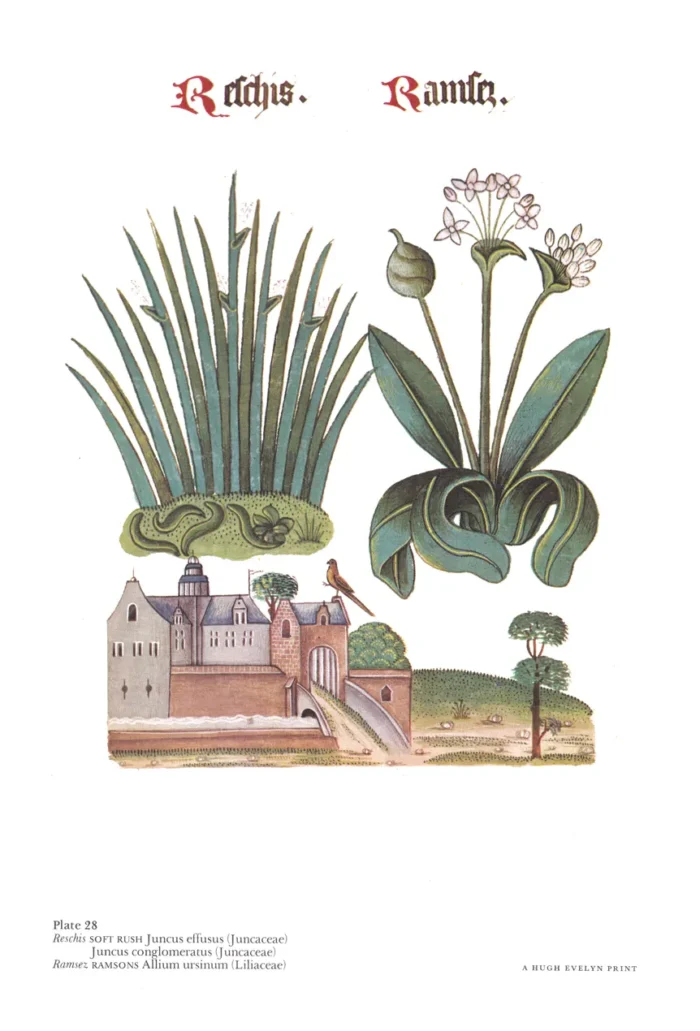Soft Rush & Ransons
£20.00
Soft Rush and Ransons (scroll down for a more detailed Description)
Published 1972 by © Hugh Evelyn Limited; drawn around 1525, these images were finished in gouache and watercolour (see description here)
Size: c. 23 x 33.5 cm [9 ″ x 13 ¼ ″] may vary slightly from printers’ cut 50 years ago
Printed on high white matt cardstock 144 g/sm2.
Print is STANDARD size – shipping is the same for 1 to 10 prints (based on largest print size in your order) – see Shipping & Returns.
In stock
Description
Reschis: Juncaceae is a family of flowering plants, commonly known as the rush family. It consists of 8 genera and about 464 known species of slow-growing, rhizomatous, herbaceous monocotyledonous plants that may superficially resemble grasses and sedges. They have been called ryschys, rish and rashes. The name comes from the Anglo-Saxon risc, which is related to the Italian lisca, a reed. Botanically the term now applies to the genus Juncus, of which the present Flora records 26 species in the British Isles. Some of these are closely related to form hybrids and are not easy to distinguish. The species used domestically, the Soft Rush, was called Juncus communis and is divided into two species, Juncus effusus and Juncus conglomeratus, both widely distributed throughout the British Isles. The two main uses were to strew on floors and to provide the wick for rush lights. The pith in the centre of the stems and leaves being flammable. In his Letter XXVI to Daines Barrington (1) dated 1 November 1775, Gilbert White (2) of Selborne describes how the Rushes are peeled and dipped in grease. He analyses the economics of this procedure, concluding, based on the price of grease and rushes and the time the finished lights burn, that ‘a poor family will enjoy five and a half hours of comfortable light for a farthing.’ Ramsez: Allium ursinum known as ramsons, buckrams, wild garlic, broad-leaved garlic, wood garlic, bear leek, or bear’s garlic, is a wild relative of chives native to Europe and Asia. The Latin name is due to the brown bear’s taste for the bulbs and its habit of digging up the ground to get at them; they are also a favourite of wild boar. The name also comes to us from the Anglo-Saxon hramsa, deriving from the Danish, Swedish and Icelandic word ram, which means rank, as used by Hamlet (3) to describe his offence – ‘it stinks to high heaven’. The word hramsan is the plural (in the same way as oxen is of ox) so Ramsons, or Ramsies (another old form) is a double plural. The name appears in several place-names, Ramsey (Essex) meaning Ramson Island, and Ramsbottom (Lancashire) which means Ramson valley. Ramsons (Allium ursinum) are also known as buckrams, wild garlic, broad-leaved garlic, wood garlic, bear leek, or bear’s garlic. It is a wild relative of chives native to Europe and Asia. Ramsons occur widely in damp woods and shady places, and often cover large areas of ground. From the same genus as the onion, leek, and garlic, they have a strong scent giving rise to local epithets like Stinking Lilies and Stink Plant. It is sometimes used in cookery which may be why one local name is Gypsy’s Onions. Grigson (4) reproduces a woodcut from Fuchs (5) (1542).
Additional information
| Weight | 0.0094 kg |
|---|---|
| Dimensions | 24 × 33.7 cm |





